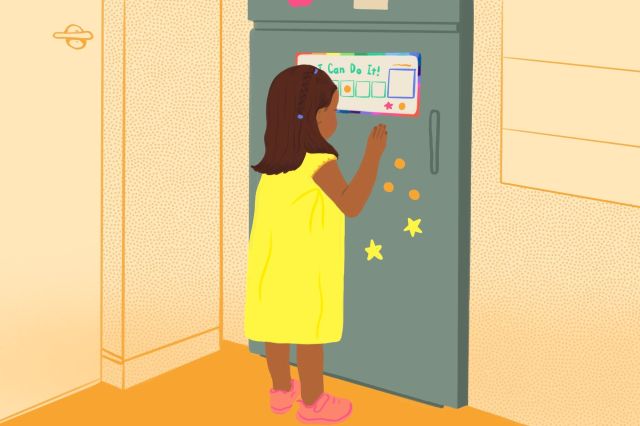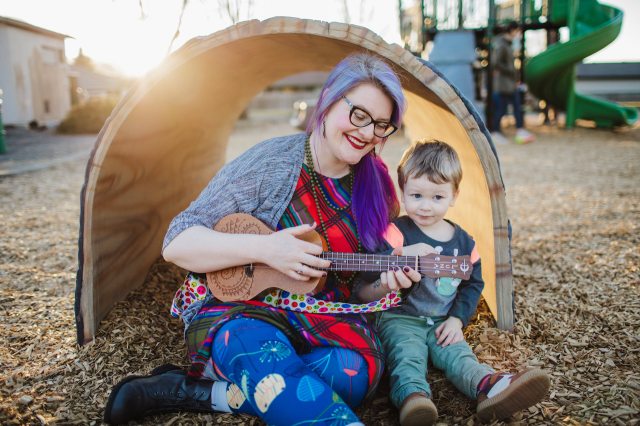Our foray into the reward system started when we were potty-training our son. Just shy of 3 years old with chunky legs and baby cheeks, he’d scramble off the toilet and run to us triumphantly, demanding, “Two M&Ms! Two M&Ms!”
Because that was the deal: If he went poop on the potty, he would get two M&Ms.
We had, of course, tried teaching him to use the potty without resorting to candy, but praise and encouragement just didn’t work for him, and M&Ms did the trick on the first try. They’re so small, I thought. What harm can they do?
Things went on like that. When he was 4, we would give him a nickel every time he said hello to people who said hi to him (this was hard for him). In second grade, he’d get stars on a chart when he brushed his teeth or got ready for bed or showed extra kindness to his siblings. As a fourth-grader, he’d get points for cleaning his room, doing his homework, paying attention in Zoom calls. The points always led to a prize of some sort—a special outing, a toy, a sweet treat.
Well, I’m here to tell you we did it all wrong.
Because now he’s 11, and if I ask him to do something—Can you watch your sister for a few minutes while I cook dinner? Can we work on your science fair project? Will you make your bed?—he’ll almost always ask, “What will you give me?”
Looking back, I realize the rewards are great for getting my kids to do things, but they don’t make my kids care about the things they do.
“Getting the child to potty because they get a sticker is not the same thing as the child choosing the growth and independence of going on the potty,” says Abigail Wald, founder of Mother Flipping Awesome, an online support community designed to help parents of strong-willed children. “We are securing the behavior but not the learning path that results in that behavior. It’s like dangling a carrot—the child said yes to the carrot but not the actual thing.”
She adds: “When a parent does a reward or sticker chart, they’re doing it based on what the parent wants and not what’s in the best interest of the child’s learning. They’re creating a system to control the child’s behaviors.”
Here’s the thing: Rewards work—at least in the short term. Tell a kid he’ll get a lollipop after dinner if he eats all his peas, and he’ll probably eat the peas. But will it make him choose peas the next time you put them on his plate? Probably not. In fact, studies have found that reward charts and similar “token economy” programs (like the sort used in schools, where kids get tokens for good behavior that they can trade in for prizes) rarely produce long-lasting changes in children. A child promised a treat for acting responsibly, for instance, “has been given every reason to stop doing so when there is no longer a reward to be gained,” writes Alfie Kohn, author of Beyond Discipline, in a blog post.
Of course, there may be a time and place for sticker charts, especially if the reward is just the sticker itself (instead of some future prize). Developmental psychologist Jennifer Silvers, who leads UCLA’s Social Affective Neuroscience & Development Lab, explained that stickers are OK if they make the child feel proud and motivate good behavior—but “not to make a big deal of it” because it can make a child overly focused on the tit-for-tat behavior/reward structure.
So what’s a parent to do? Here are some things to remember, especially with children under 4:
Model Good Habits
Modeling the right behaviors can work wonders. Instead of giving kids stickers for taking off their shoes when they come in from outside, for instance, make a big deal when you do it. Every time (they’ll catch on eventually, we promise!). Just announce, Time to take off my shoes so I don’t get mud all over the house. Often, the kids will take the cue and do the same thing.
Focus on the Behavior (Instead of the Prize)
If getting a sticker helps motivate your young child to brush his teeth, that’s OK. But let the reward be only the sticker itself—and the praise for doing whatever earned it (i.e., “Wow! Your teeth are so clean!”) Be sure to talk about why brushing teeth is so important—and don’t promise a big reward. Let the chart be just a way to keep track of your child’s progress.
Set Small, Tangible Goals
Break down the positive behaviors you want into specific pieces. Rather than say ‘clean up your room,’ which can be overwhelming for small children, Silvers says, just help them get involved in the cleaning process. Ask them to hand you the stray toys, so you can put them on the shelf, for instance. It’s a little work for you, but it means less fighting and more helping.
Don’t Give Points for Acts of Kindness
If you want to give a sticker when your child cleans his room or picks up toys, that can be OK. But don’t give points or prizes for kindness, since it’s more important to teach the value of kindness without any physical motivation. For example, don’t reward your child just because she shared her sand toys at the playground. Instead, use that as an opening for a conversation about how nice it is to share.
Don’t Resort to Bribery
While offering a prize can be an easy way to get your child to behave when you really need him to—e.g., “If you behave nicely at the grocery store, I’ll get you a treat at the checkout line”—it’s best to avoid this when possible (we know, sometimes that’s hard!). Offering a prize for good behavior is essentially bribery, so try not to frame it that way.
Praise the Value of Good Behavior
Sometimes, the best way to teach good behavior is to remind children how they can make a difference. If your child helped you set the table, for instance, point out to everyone at dinner how nice the table looks because she helped set it. If your child helped stir the pancake batter, tell everyone that the pancakes taste extra yummy because she helped make them. This reaffirms the value of the behavior and makes the child feel proud just for doing the deed itself (not because there was any specific reward).
Make Your Own Motivational Chart
Wouldn’t it be nice if children learn to motivate themselves, rather than wait for you to promise a prize? Show them how that’s done! If you want to exercise more, for instance, say something like, Mommy really needs to exercise, so I’m going to make this chart to motivate me. Then put a check in a box every time you exercise and give yourself lots of praise: That’s three days in a row that I exercised! I feel so healthy and happy! Hopefully, your little will see how excited you are to achieve your own goals and will learn to do the same someday.
Chore Charts Are OK for Older Children
When kids get older (8 and up), they can understand long-term goals a little better, so having reward or chore charts for everyday household tasks can help kids keep track of what they have to do as well as make them see when they’re doing—or not doing—their part.
“When the child is older, it can be wonderful,” says Wald, who does regular podcasts to help parents navigate common challenges. “You can say, ‘You know yourself—would it excite you to work for a reward? Then you’re teaching the child how they work. You make it between them and them: You tell them, ‘I’m not the keeper of the reward chart. I’m going to hand you all the stickers. What are you challenging yourself with?’ A child who is under 6 or 7 cannot comprehend that motivation.”
























